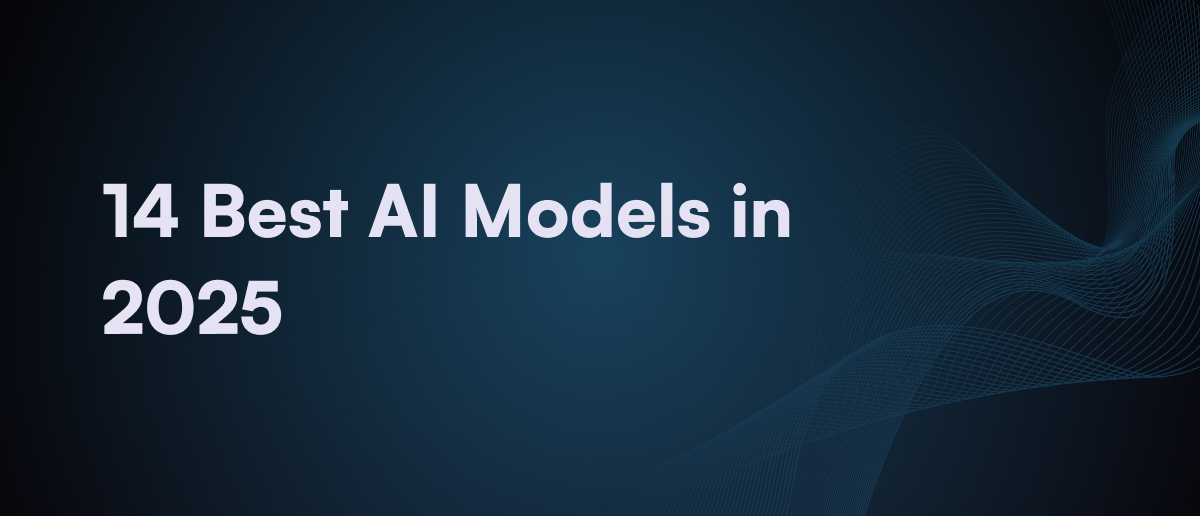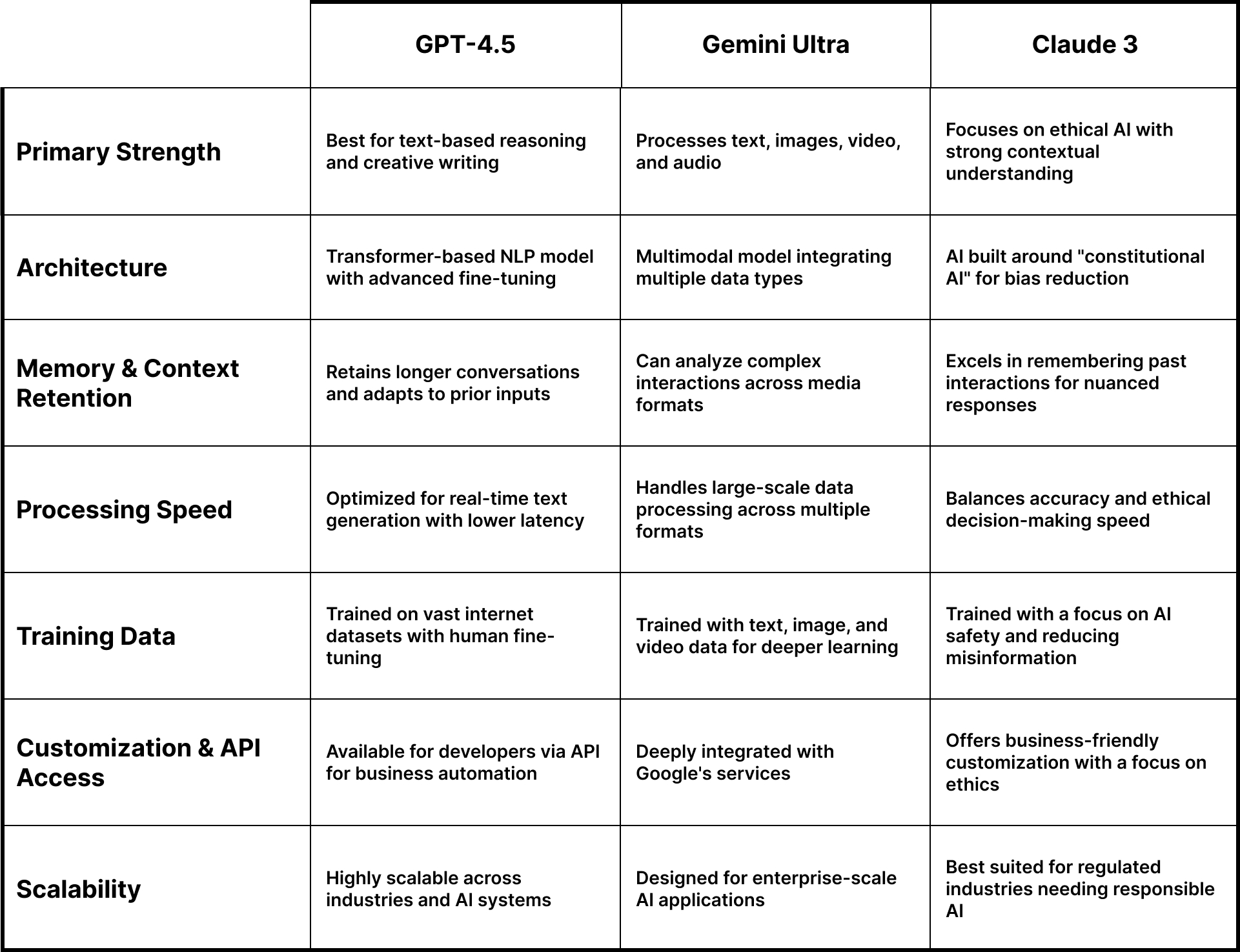Top 14 AI Models in 2025 for Businesses to Watch


By : Kasturi Goswami

Last Updated: March 28, 2025

14 min read
Table of Contents
Build Your No-Code Custom AI Agent
Get Started FreeThe AI war is on.
Tech giants—OpenAI, Google DeepMind, Meta, and a swarm of challengers—are racing to build the smartest, fastest, and most dominant AI.
This isn’t just innovation. It’s an AI arms race. Each breakthrough brings us closer to a future where AI doesn’t just assist; it thinks, learns, and transforms reality.
2025 isn’t just about who has the best AI model. It’s about who builds the AI that runs the world. The battle is fierce. Every player is pushing harder, scaling bigger, and evolving faster.
But which AI stands at the top?
Some models write better. Others see better, think deeper, or predict faster. In this listicle, we break down the most powerful and popular AI models, so you know exactly who’s leading the AI revolution and who’s just trying to catch up.
Top Must-Know AI Models
What is the most powerful AI model in 2025?
The strongest AI models don’t just process data; they think, reason, and create. Some talk like humans, some decode complex logic, and others write code like expert engineers.
Here are the AI behemoths that define power, precision, and innovation in 2025:
- Developer: OpenAI
- History: Anticipated successor to GPT-4, refining reasoning, memory, and response accuracy.
- What it does: A state-of-the-art language model for writing, coding, and automation.
- Key features:
- Enhanced accuracy & fewer hallucinations
- Improved long-context retention
- Faster, more nuanced text generation
- Better multilingual capabilities
- Why it’s powerful: The gold standard for AI-generated text, automation, and research.
- Use case:
- AI-powered chatbots, content creation, and legal research
- Code assistance & debugging
- Intelligent virtual assistants
- enhance customer support
- streamline workflows
- and improve response accuracy
Tidbit
- GPT is at the core of many AI-powered applications, from chatbots to automation tools. Its ability to understand context, generate human-like responses, and process complex queries makes it ideal for AI agents, virtual assistants, and business automation.
As such, companies integrate GPT into their AI systems to:
- Developer: Google DeepMind
- History: Google’s multimodal AI, combining text, image, and video analysis.
- What it does: Processes multiple data types simultaneously for deeper AI understanding.
- Key features:
- Multimodal intelligence (text, image, video, and audio)
- Real-time analysis & response generation
- Deep integration with Google’s ecosystem
- AI-powered creative content generation
- Why it’s powerful: The best AI for cross-media applications and knowledge synthesis.
- Use case:
- AI-powered search & research tools
- Creative AI content generation
- Smart virtual assistants with deep knowledge
- Developer: Anthropic
- History: Built for AI safety, transparency, and bias reduction.
- What it does: Ensures context-aware, responsible AI interactions.
- Key features:
- Long-memory retention
- Bias detection & misinformation prevention
- Business-ready AI integration
- Why it’s powerful: The best choice for companies that prioritize AI ethics and compliance.
- Use case:
- AI-driven content moderation
- Legal & compliance AI assistants
- Ethical AI-powered chatbots

- Developer: Meta
- History: Meta’s response to GPT models focused on open-source AI research.
- What it does: A scalable language model for developers and businesses.
- Key features:
- Optimized for research & NLP
- Open-source accessibility
- Customizable for business applications
- Why it’s powerful: A top open-source alternative to proprietary AI models.
- Use case:
- AI-assisted research & automation
- Custom NLP models for businesses
- AI-powered chatbots
Tidbit
- Zapier in a detailed article, Meta AI: What is Llama and Why Does It Matter? had covered everything from Llama's development history—from its earliest version to its latest advancements—to how it compares with other leading AI models in the market.
According to the automation giant, Llama is a pretty big deal for unlike other market popular LLMs that are proprietary and closed source, Llama is open sourced and can be downloaded and implemented after being trained on your own data.
- Developer: DeepSeek AI
- History: A rising AI model specializing in mathematical reasoning and finance.
- What it does: Optimized for structured problem-solving and financial forecasting.
- Key features:
- AI-driven financial analysis
- Logic-based decision-making
- Risk assessment capabilities
- Why it’s powerful: A leading AI model for finance, forecasting, and scientific research.
- Use case:
- AI-driven stock market predictions
- Business forecasting & decision-making
- AI-powered risk assessments
Check out the video to know exactly what this innovative AI reasoning model is all about.
- Developer: xAI (Elon Musk’s AI team)
- History: Launched in November 2023 as a generative AI chatbot integrated with X (formerly Twitter). Grok has undergone several updates, with Grok-3 released in February 2025, trained with significantly more computational power and an expanded dataset.
- What it does: Designed for real-time conversational AI, capable of accessing up-to-date information from X and the broader internet. It offers features like web search, citations, and image generation through its Aurora model.
- Key features:
- Real-time conversational AI
- Business automation integration
- Context-aware discussions
- Why it’s powerful: Grok's integration with X allows for immediate access to real-time information, making it a strong competitor in AI chatbot applications.
- Use case:
- Enterprise AI chatbots
- AI-driven customer support
- Automated business intelligence
- Read all about Grok 3 Beta — The Age of Reasoning Agents
- Developer: Cohere
- History: Designed for enterprise-level AI solutions.
- What it does: Powers business NLP applications, automation, and intelligent search.
- Key features:
- Enterprise AI model fine-tuning
- AI-powered search & chatbots
- Custom AI applications
- Why it’s powerful: A flexible NLP model for enterprise needs.
- Use case:
- AI-powered chatbots
- Business intelligence & automation
- AI-powered data analysis
Tidbit
- Cohere CEO Aiden Gomez, in a discussion with author Stephen Marche, compared AI's impact to the steam engine’s role in the Industrial Revolution. He believes AI will soon learn independently, uncovering insights beyond human discovery and driving a new era of intellectual progress.
- Developer: Mistral AI
- History: Built as a fully open-source AI alternative to proprietary models like GPT and LlaMA. Mistral AI is known for high efficiency, strong performance, and transparency.
- What it does: A cutting-edge language model optimized for natural language processing (NLP), translation, and AI-driven automation.
- Key features:
- Fully open-source & customizable for developers
- High-speed NLP processing with strong accuracy
- Cost-effective AI solutions without reliance on major cloud providers
- Why it’s powerful: The best independent AI model for businesses, researchers, and developers who want open-source AI without big-tech restrictions.
- Use case:
- AI-powered automation & research
- AI-driven chatbots & NLP applications
- Custom AI solutions for enterprises & developers
Tidbit
- Mistral AI claims that Le Chat, its AI assistant, delivers the fastest inference speed on the market, outperforming competitors like Claude and GPT. The company backs this with benchmark tests, showcasing its model’s ability to generate responses with minimal latency. For proof, check out their reference video.
- Developer: Google AI
- History: Introduced in 2018, BERT transformed natural language processing (NLP) by enabling AI to understand words in relation to their surrounding context. It significantly improved search engines, chatbots, and text-based AI applications by providing deeper language comprehension.
- What it does: BERT processes text bidirectionally, meaning it considers both previous and next words in a sentence. This approach allows AI to better understand intent, sentence structure, and complex language patterns, making it highly effective for NLP tasks.
- Key features:
- Bidirectional language understanding for improved accuracy in text interpretation
- Pre-trained on vast datasets and fine-tuned for specific applications
- Supports multiple languages for global NLP tasks
- Enhances search engine ranking and natural language queries
- Why it’s powerful: BERT is very different from its predecessors. Its deep contextual understanding has significantly improved search results, conversational AI, and content analysis.
- Use case:
- AI-powered search optimization & result accuracy
- AI-driven chatbots with natural, context-aware responses
- Custom AI solutions for sentiment analysis & content filtering
- AI-enhanced multilingual translation & contextual understanding
- AI-powered recommendation & personalization engines
- BERT is an acronym and stands for Bidirectional Encoder Representations from Transformers.
- Google DeepMind has another powerful LLM up its sleeve—Chinchilla AI. Designed for efficiency, it outperforms larger models despite using fewer parameters. However, it is not publicly available and remains a research-focused AI within DeepMind.
Tidbit
- Developer: Microsoft
- History: Part of Microsoft’s Turing series, Turing-NLG is a massive natural language generation model designed for AI-powered writing, search, and automation.
- What it does: One of the largest language generation models, optimized for content creation, search engines, and automated business insights.
- Key features:
- State-of-the-art long-form text generation
- Advanced search ranking & contextual AI comprehension
- Multilingual text processing & summarization capabilities
- Why it’s powerful: A highly scalable enterprise-grade AI model, perfect for content-heavy industries, research, and AI-driven business insights.
- Use case:
- AI-generated reports, articles, and technical documentation
- AI-enhanced search engines for improved ranking & relevance
- AI-driven market analysis & business intelligence
Tidbit
- Microsoft and NVIDIA built Megatron-Turing NLG 530B, a powerful AI model, by combining Megatron and Turing NLG. With DeepSpeed and the latest Megatron-LM, it keeps advancing. It’s also publicly available for research and use.
- Developer: Baidu
- History: Built to dominate China’s AI ecosystem.
- What it does: Excels in Chinese NLP and AI-driven enterprise automation.
- Key features:
- Mandarin NLP optimization
- AI-powered business integration
- High-speed AI responses
- Why it’s powerful: The leading AI model in China.
- Use case:
- AI-driven automation for businesses
- AI-powered Chinese content generation
- AI-assisted chatbots for Mandarin speakers
Tidbit
- With competition heating up, Chinese search engine giant Baidu has announced plans to make its next-generation AI model Ernie open-source from June 30, 2025.
- Developer: DeepMind
- History: First introduced in 2018 as an AI model for predicting protein structures. It gained global recognition after winning the CASP13 and CASP14 competitions. AlphaFold 2, released in 2020 and subsequently AlphaFold 3, launched in 2024.
- What it does: It predicts the 3D structures of proteins from amino acid sequences, solving one of the most complex challenges in molecular biology.
- Key features:
- Deep learning-based protein structure prediction
- High accuracy, outperforming traditional lab-based methods
- Expanded capabilities to predict biomolecular interactions
- Open-access structure database for scientific research
- Why it’s powerful: It significantly reduces the time and cost required for structural analysis.
- Use case:
- Drug discovery and molecular engineering
- Understanding genetic diseases and protein malfunctions
- Accelerating synthetic biology and biopharmaceutical research
- Predicting protein interactions for biotechnology applications
Tidbit
- Google DeepMind has another strong contender, the AlphaCode AI. Though the AI model itself isn't directly available for public use, DeepMind released a dataset of competitive programming problems and solutions on GitHub, including tests, to help others build on their research.
- Developer: OpenAI & GitHub (Microsoft)
- History: Designed for real-time coding assistance.
- What it does: Suggests and optimizes code as developers write.
- Key features:
- Context-aware coding suggestions
- AI-powered debugging
- Code completion automation
- Open-access structure database for scientific research
- Why it’s powerful: The best AI for developer productivity.
- Use case:
- AI-assisted software development
- Code debugging & optimization
- Learning tool for new developers
- Additional read: 20+ AI chatbot examples changing CX in 2025
- Developer: Hugging Face & AI Research Community
- History: Developed as an open-access NLP model, Bloom is one of the largest collaborative AI projects designed for research, education, and multilingual AI applications.
- What it does: Focuses on multilingual text generation, translation, and NLP research.
- Key features:
- Open-source, community-driven AI model
- Ideal for multilingual applications
- Designed for AI research, academic projects, and open experimentation
- Why it’s powerful: One of the most transparent and accessible AI models, perfect for global language processing and academic research.
- Use case:
- AI-powered multilingual translation & text generation
- Open-source AI projects & academic research
- AI-driven language learning & localization
Tidbit
- Bloom is able to output coherent text in 46 languages and 13 programming languages that is hardly distinguishable from text written by humans.
Which popular AI models are the most accurate & reliable?
Accuracy in AI isn’t just about fewer mistakes—it’s about context, precision, and real-time adaptability. The most reliable AI models in 2025 are those that think critically, retain information, and improve with use.
But the question is how are AI models improving accuracy in 2025?
- Fewer AI hallucinations – Earlier, AI used to generate incorrect or made-up information (known as "hallucinations"). Now, advanced training techniques and reinforcement learning with human feedback (RLHF) are helping AI cross-check facts, filter misinformation, and provide more reliable answers.
- Better context retention – Instead of losing track of previous messages, new AI models have long-term memory capabilities. This means more fluid, natural conversations, where AI remembers details, follows up on past topics, and offers better continuity in responses—making interactions feel more human-like.
- Real-time fact-checking – Some AI models now integrate live data sources, pulling in real-time news, updated statistics, and verified information to ensure responses are up-to-date. This reduces outdated answers and improves AI’s ability to self-correct errors before responding.
- Stronger decision-making – Instead of just responding to prompts, modern AI now reasons through problems. It weighs different options, predicts outcomes, and chooses the best response based on logic and probabilities. This is especially useful in fields like finance, law, and scientific research, where AI needs to provide strategic insights, not just generic answers.
For example, consider these AI models:
✅ GPT – Best for long-form text accuracy, deep reasoning, and business intelligence.
✅ Claude – Designed for bias-free, ethical AI with long memory retention.
✅ DeepSeek – A powerhouse for mathematical accuracy, structured logic, and financial forecasting.
✅ Gemini – Excels in multimodal intelligence, real-time fact-checking, and media analysis.
✅ Turing – Enterprise-grade AI for high-accuracy text generation, search, and analytics.
Which AI model should businesses use in 2025?
Picking the best AI model is not about finding one perfect model—it’s about finding the right model for the right job.
Think of AI models like a construction team. You wouldn’t use a jack hammer for painting or a blueprint software for drilling. Just like different specialists handle different tasks—architects design, engineers calculate, and workers build—AI works the same way. One model won’t do it all.
You need a multi-model approach to ensure adaptability, efficiency, and long-term success.
According to Nicholas Renotte, Chief AI Engineer at IBM Client Engineering, AI model selection should be goal-driven. Businesses must consider model accuracy, efficiency, cost, and adaptability when integrating AI into their workflows. He emphasizes that no single AI model can cover every scenario, making a multi-model strategy essential for businesses that aim to stay competitive.
Before choosing an AI model, ask:
- Who built it?
- What data trained it?
- What are the risks?
- What guardrails are in place?
So, ultimately, the discussion boils down to the fact that AI accuracy depends on your needs. For instance:
- If you need AI for content, chatbots & automation → GPT, Claude
- If you want AI to analyze multiple formats at once → Gemini
- If your business relies on logical accuracy & financial modeling → DeepSeek, Mistral
- If AI needs to power enterprise search & analytics → Turing, Cohere
No single AI model can do it all.
Just like a well-run construction site, AI models need regular updates, testing, and re-evaluation. Sticking to a single model forever means you’ll eventually fall behind.
AI is evolving fast, and only businesses that adapt will gain the most. Stay informed, experiment, and grow with AI’s unstoppable progress.
- You might also like to check out other relevant reads like:
- 7 AI Agent Trends In 2025
- 30+ Best AI Tools for Business Success in 2025
- Everything you should know about multi-agent AIs before investing